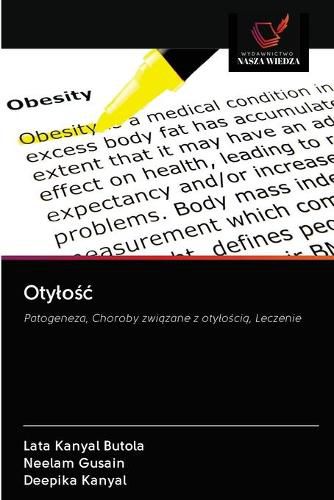Readings Newsletter
Become a Readings Member to make your shopping experience even easier.
Sign in or sign up for free!
You’re not far away from qualifying for FREE standard shipping within Australia
You’ve qualified for FREE standard shipping within Australia
The cart is loading…






This title is printed to order. This book may have been self-published. If so, we cannot guarantee the quality of the content. In the main most books will have gone through the editing process however some may not. We therefore suggest that you be aware of this before ordering this book. If in doubt check either the author or publisher’s details as we are unable to accept any returns unless they are faulty. Please contact us if you have any questions.
Otylosc jest definiowana jako nieprawidlowe lub nadmierne nagromadzenie tluszczu, ktore moze negatywnie wplywac na zdrowie. Wedlug Swiatowej Organizacji Zdrowia (WHO), osoba o wskazniku masy ciala (BMI) wiekszym lub rownym 30 kg/m2 jest otyla i ciezka lub klasa III otylosci jest zdefiniowana jako BMI rowny lub wiekszy niz 40 kg/m2; termin ten jest rowniez uzywany dla osob z BMI pomiedzy 30 a 39,9 kg/m2, ktore maja znaczace wspolistniejace choroby. National Institute of Clinical Excellence (NICE) zaleca operacje bariatryczne dla takich osob. Czestosc wystepowania ciezkiej otylosci znacznie wzrosla w ciagu ostatnich dwoch do trzech dekad. Meksyk i Stany Zjednoczone Ameryki Polnocnej maja najwyzsza chorobowosc na swiecie, a Wielka Brytania jest liderem w Europie. BMI jest stosowany jako substytut otylosci. Istnieja inne metody, takie jak analiza bioimpedancyjna, absorpcjometria rentgenowska o podwojnej energii (DEXA), hydrometria, tomografia komputerowa (CT), rezonans magnetyczny (MRI) i inne, ale dla wszystkich celow klinicznych i interwencyjnych, BMI jest uzywany jako miara otylosci.
$9.00 standard shipping within Australia
FREE standard shipping within Australia for orders over $100.00
Express & International shipping calculated at checkout
This title is printed to order. This book may have been self-published. If so, we cannot guarantee the quality of the content. In the main most books will have gone through the editing process however some may not. We therefore suggest that you be aware of this before ordering this book. If in doubt check either the author or publisher’s details as we are unable to accept any returns unless they are faulty. Please contact us if you have any questions.
Otylosc jest definiowana jako nieprawidlowe lub nadmierne nagromadzenie tluszczu, ktore moze negatywnie wplywac na zdrowie. Wedlug Swiatowej Organizacji Zdrowia (WHO), osoba o wskazniku masy ciala (BMI) wiekszym lub rownym 30 kg/m2 jest otyla i ciezka lub klasa III otylosci jest zdefiniowana jako BMI rowny lub wiekszy niz 40 kg/m2; termin ten jest rowniez uzywany dla osob z BMI pomiedzy 30 a 39,9 kg/m2, ktore maja znaczace wspolistniejace choroby. National Institute of Clinical Excellence (NICE) zaleca operacje bariatryczne dla takich osob. Czestosc wystepowania ciezkiej otylosci znacznie wzrosla w ciagu ostatnich dwoch do trzech dekad. Meksyk i Stany Zjednoczone Ameryki Polnocnej maja najwyzsza chorobowosc na swiecie, a Wielka Brytania jest liderem w Europie. BMI jest stosowany jako substytut otylosci. Istnieja inne metody, takie jak analiza bioimpedancyjna, absorpcjometria rentgenowska o podwojnej energii (DEXA), hydrometria, tomografia komputerowa (CT), rezonans magnetyczny (MRI) i inne, ale dla wszystkich celow klinicznych i interwencyjnych, BMI jest uzywany jako miara otylosci.